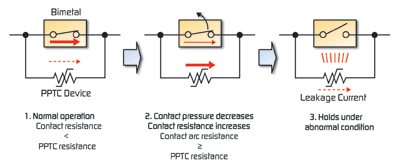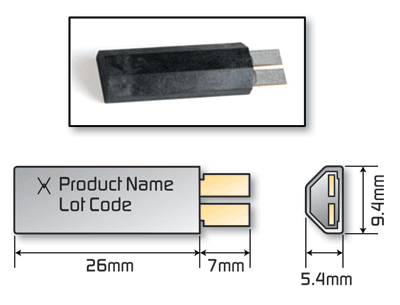Protecting high-rate-discharge Li-ion battery packs
Market demands for lighter, smaller equipment force battery designers to provide high reliability in less space
BY TY BOWMAN
Global Battery Market Manager
TE Circuit Protection
www.circuitprotection.com
High-rate-discharge lithium-ion (Li-ion) battery pack applications require robust, reliable circuit protection. At the same time, increasing market demands for lighter, smaller equipment means these battery designs must provide high reliability while using less space. With this market requirement in mind, a new metal hybrid PPTC (MHP) device has been developed. It can help replace or reduce the number of discharge FETs and accompanying heat sinks used in some complex IC/FET battery protection designs while enhancing safety and performance.
Conventional approach
The conventional approach to circuit protection for high-rate-discharge Li-ion battery applications (such as cordless power tools, e-bikes, and backup power supplies) involves techniques that tend to be large, complex, or expensive. For example, some circuit protection design approaches might use a combination of ICs and MOSFETs or similar complex solutions.
Other designs might use a conventional bimetal protector in dc-power applications requiring 30-A+ hold current. However, this approach requires contacts large enough to handle the high current and results in large device size. Additionally, the number of switching cycles in these conventional bimetal protectors must be limited due to the possibility of damage from arcing between the contacts.
Hybrid approach
The MHP device connects a bimetal protector in parallel with a polymeric positive temperature coefficient (PPTC) device. This combination helps provide resettable overcurrent protection while using the low resistance of the PPTC device to help prevent arcing at higher currents while also heating the bimetal to keep it open and in a latched position. Figure 1 shows the activation steps of the MHP device, which include:
1. During normal operation, because contact resistance is very low, most of the current goes through the bimetal.
2. When the contact begins to open, contact resistance increases quickly. If the contact resistance is higher than the PPTC device’s resistance most of current goes to the PPTC device and no — or less — current remains on the contact, therefore preventing arcing between the contacts. When current shunts to the PPTC device, its resistance rapidly increases to a level much higher than the contact resistance and the PPTC heats up.
3. After the contact opens, the PPTC device starts to heat up the bimetal and keeps it open until the overcurrent event ends or the power is turned off.

Fig. 1: Activation steps of the metal hybrid PPTC (MHP) device. (a) Normal operation: contact resistance is less than PPTC resistance. (b) Contact pressure decreases; contact resistance increases; contact arc resistance is greater than or equal to PPTC resistance. (c) Holds under abnormal condition.
Compared to ceramic PTCs, the polymer PTC device’s resistance is much lower. This means that even when the contact opens just a small amount, the contact resistance increases only slightly and the current can be shunted to the PPTC device and helps prevent arcing on the contacts. Typically, the resistance difference at room temperature between ceramic and polymer PTC devices is in the range of two decades (x102 ); so when the higher-resistance ceramic PTC devices are combined in parallel with a bimetal they are less effective than the MHP device at suppressing arcs at higher currents.
Contact size and resistance
On a typical bimetal protector the contact is located in only one place so it may exhibit weak voltage-withstand characteristics. Because higher currents would require a much larger form factor in a single contact design, the MHP device uses a type of contact that is referred to as a “double-make” or “double-break” design in order to reduce the size of the device. This technology offers several advantages as compared to a typical bimetal protector:
1. The device exhibits very low resistance because the current path is very short.
2. Heat is only generated at the contact point, permitting the use of thermal control to achieve precise thermal activation.
3. It enables MHP devices to have a smaller form factor compared to other breaker devices with a similar rating.
In comparison, because the standard bimetal contact is located in only one place, it generally has weaker voltage withstand characteristics than the MHP device.
Impact/shock withstand
The MHP device can be used in the harsh operating environments of high-current applications by providing both longer cycle life and high vibration/shock withstand. A typical power tool battery pack operates under severe vibration and impact conditions. To provide adequate protection, the MHP device needs sufficient contact pressure between the contacts.
Standard protector devices typically use an arm with strong spring tension to keep the movable contact on the fixed contact. But the spring tension is usually insufficient to maintain contact pressure under strong impact or vibration conditions — even if a strong spring is used.
To overcome this challenge, design efforts for the MHP device focused on the bimetal disk, since a formed bimetal disk has sufficient strength to stay flat when there is no heat or thermal contact. In addition, a “hook” was added to the movable arm to enhance the contact pressure provided by the bimetal disk. The movable arm is a cantilever held by a pin located on the opposite side of the device. When a hook is added close to the contact the movable arm rotation is reduced, resulting in a robust downward force on the two contacts. The MHP has survived testing of 1,000 impacts in a 1500 g (g-force) drop test without failure, and as many as three impacts at 3,000 g.
Device specifications
The MHP30-36 device, the first device in a planned family of MHP products, has a 36-Vdc/100-A maximum rating and a time-to-trip of under five seconds at 100 A at 25C. The device’s hold current is 30 A and the initial resistance is under 2 mΩ, which is less than typical bimetal protectors that are generally rated at 3 to 4 mΩ.
The time-to-trip at 50 A is 25 s ±5 s. This value is short enough to help protect the battery pack from overheating due to an over-discharge event and is also long enough to not inconvenience the power tool operator.
The time-to-trip at 100 A is the most important parameter in terms of protecting the battery pack from any abnormal situation, such as power tool (drill) rotor lock. As such, the time-to-trip should be no longer than five seconds. The reset time (time to return power to the tool) should be no longer than 30 s, a duration that balances user convenience with time needed to keep the battery from overheating.
Figure 2 shows the shape and dimension of the MHP device, which is rated at 30-A hold current and is the same size as a typical bimetal protector with only a 15-A rating. Additionally, the device has flat corners on one side so that it fits snuggly between standard 18-mm diameter Li-ion cells in a battery pack.

Fig. 2: Tshows the shape and dimension of the MHP device.
The hybrid MHP device integrates a bimetal protector with a PPTC device to provide resettable overcurrent protection, using the low resistance of the PPTC device to help suppress arcing at higher currents. This approach provides a rugged, resettable circuit protection solution that gives Li-ion battery pack designers a method for optimizing space, reducing cost, and meeting the requirements of future battery safety standards.
The MHP device’s scalable technology can be configured for various applications. Higher-voltage (up to 400 Vdc) and hold-current (60 A) devices are currently in development. Design concepts for protecting Li-ion battery packs and modules used in solar power systems and other back-up power applications are also being developed. Incorporating a third terminal as a signal line, these MHP devices will use smart activation detection to monitor the battery’s various vital functions. ■
Advertisement
Learn more about TE Circuit Protection Group





